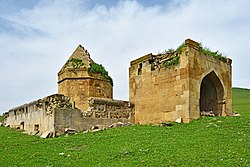| Kalakhana tombs | |
|---|---|
| Native name Kələxana türbələri (Azerbaijani) | |
 One of the tombs within the complex One of the tombs within the complex | |
 Archaeological map of westernmost tomb Archaeological map of westernmost tomb | |
| Type | tomb |
| Location | near Kalakhana, Shamakhi District, Azerbaijan |
| Coordinates | 40°35′26″N 48°36′07″E / 40.590543°N 48.601855°E / 40.590543; 48.601855 |
| Area | 3.5 hectares (8.6 acres) |
| Built | 17th century |
| Architect | Amir Ali oglu Abdulazim |
| Architectural style(s) | Shirvan-Absheron |
| Governing body | Government of Azerbaijan |
 | |
Kalakhana tombs (Azerbaijani: Kələxana türbələri), is a complex of tombs located 6 kilometres (3.7 mi) north of the Azerbaijani city of Shamakhi, near Kalakhana (present-day Shahriyar). Eight of the nine tombs within the complex have survived, one of which has been severely damaged. Other tombs are still in good condition, and some are undamaged.
Only one of the tombs has an inscription on it. It contains information about the date of construction of the monument and the identity of the person buried there. It is known from this inscription that the tomb was built in 1663 or 1664 by the architect Amir Ali oglu Abdulazim.
History
Until the end of the 19th century, the Kalakhana tombs were rarely covered in the scientific literature, and the architectural features of the monuments within the complex were not thoroughly studied. Eight of the nine tombs within the complex have survived, one of which has been severely damaged. Other tombs are still in good condition, and some are undamaged. Remains of the defensive walls surrounding the three tombs have also survived. However, only one of them is in a position to allow a scientific restoration of the original appearance of the complex.
According to Cornelis de Bruijn, five of the nine tombs are surrounded by walls with portal entrances. The farthest tomb was surrounded by a double wall. The archaeologist writes that there were 5 graves in the first tomb and 3 graves in the second tomb. He writes that although at first glance less than nine tombs can be seen, the hill in which the tombs are located is called the seven domes. De Bruijn also notes that there was a castle on the site of the tomb complex and a spring nearby.
Kalakhana tombs are one of the unique complexes among the architectural monuments of Medieval Azerbaijan to be built within a short time of period. According to the Soviet–Azerbaijani architect and critic Abdulvahab Salamzadeh, one of the main facts proving that the tombs were constructed within a few years is that the German traveler Adam Olearius, who visited the region in 1636, did not provide any information on the tombs. However, in a book published by Cornelis de Bruijn, who visited Shirvan in the early 18th century, each of the nine tombs were already depicted. Considering that on one of the tomb inscriptions the Hijri date of 1074 (1663 or 1664 with the Gregorian calendar) other tombs may have been built in the same period, possibly by the same architect.
References
Citations
- Sysoev, Vasiliy (1926). Поездка в Шемахинский уезд с археологической целью [Archaeological trip to Shemakha district] (in Russian) (Archaeological Committee ed.).
- Salamzadeh, Abdulvahab; Sadigzadeh, A. (1946). Некоторые памятники Шемахинского района [Some monuments of Shamakhi District] (in Russian) (Architectural Monuments of Azerbaijan, issue 1 ed.). Baku. p. 90.
{{cite book}}: CS1 maint: location missing publisher (link) - Salamzadeh 1964, p. 42
- Salamzadeh 1964, p. 43
- de Bruijn, Cornelis (1711). Reizen over Moskovie door Persie en Indie (in Dutch). Amsterdam.
- Salamzadeh 1964, p. 45
Sources
- Salamzadeh, Abdulvahab (1964). Архитектура Азербайдана XVI-XIX вв [Architecture of Azerbaijan in the 16–19 centuries] (in Russian). Baku: Publishing House of the Academy of Sciences of the Azerbaijan SSR.
External links
- "Şamaxıdakı dərviş türbələri" (in Azerbaijani).
- "Kələxana türbələri" (in Azerbaijani).
- "Kələxana türbələri" (in Azerbaijani).
- "Kələxana türbələri - Tərk edilmiş tarix (Şamaxı)" (in Azerbaijani).
- "Мавзолейный комплекс XVII века" (in Russian).